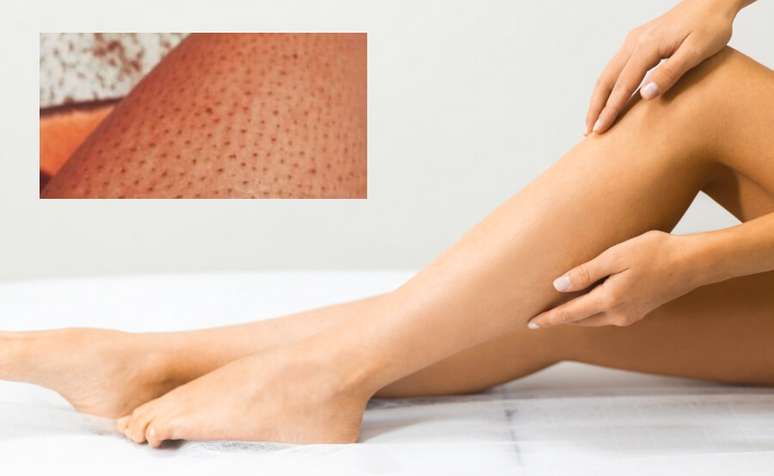Keratosis pilaris can occur on the legs due to open pores containing oil, dirt, or bacteria after waxing.
The beauty of legs is an even more widespread topic in summer, a season in which dresses are generally shorter. But this is not so easy for a group of people who suffer from a common leg problem, when dark spots and blackheads similar to strawberry seeds appear.
“Many people have nicknamed this change “strawberry legs,” as it exemplifies the medical term keratosis pilaris. These are actually open pores containing oil, dirt or bacteria, which generally appear after waxing,” says dermatologist Renato Soriani, member of the Brazilian Society of Dermatology (SBD).
“Although harmless, strawberry legs are unfortunately very common and aesthetically unsightly. But they are easy to prevent and are also treatable,” adds the doctor.
One of the least aggressive forms of treatment is Hydrabody, a body version recently arrived in Brazil of hydrodermabrasion from Hydrafacial equipment.
“It features the same Vortex-Fusion system found in the facial tips. The unique spiral design of the technology is capable of generating a vortex effect which, combined with the vacuum suction technology of the equipment, can easily expel and remove impurities from the skin while providing hydrating and nourishing solutions,” explains the doctor.
Keratin accumulation
The dermatologist explains that keratosis pilaris occurs when the skin creates a buildup of a protein called keratin – the same building block as hair, skin and nails – which creates a plug that blocks the hair follicle, causing small bumps.
“Swabbing can also trigger inflammation of the skin, which causes redness around each hair follicle,” explains the doctor.
Additionally, hair follicles can become irritated from sweat and friction, so wearing loose-fitting clothing and keeping your skin cool and dry can help. In some cases, individual points can become inflamed: “So do not touch these points, because this can cause irritation and even permanent scarring,” says the doctor.
Keratosis pilaris
According to Renato, keratosis pilaris appears most often on the back of the arms, but many people may also have small, hard bumps on their thighs, legs, and even back. Folliculitis is another condition that can have a similar appearance and is triggered by inflamed and irritated hair follicles on the thighs and legs.
“Both conditions are very common and not dangerous, but can sometimes cause itching or pain. However, people are generally only interested in the aesthetic aspect,” says the doctor. “People with sensitive skin, such as those with eczema, are more likely to have and experience symptoms of keratosis pilaris,” he says.
During treatment with Hydrabody, the doctor states that, initially, a cleansing process is carried out; Immediately afterwards, the Glysal peeling comes into play, with glycolic and salicylic acid, which according to the doctor cleanses deeply and helps to decongest the skin.
“We then select the appropriate booster for the patient’s indication, which could be Britenol to soften and improve pigmentation due to inflammation, or Dermabiulder for the infusion of vitamin C, intensive hydration and improvement of skin quality,” explains Renato .
Improve blood circulation
The technology can also help improve blood circulation, promoting healthier skin. “We use blue or red LED lights, depending on the patient’s indication, since the blue color helps fight bacteria and the red color helps in neocollagenesis,” explains Renato.
The subsequent application of the powerful antioxidant Antiox nourishes and soothes the skin, as it contains nutrients, antioxidants and calming ingredients based on algae and menthol.
“It is considered cutting-edge technology that promotes deep cleansing, exfoliates the skin, has a peeling and hydrating action with booster; Therefore, the improvement of keratosis is gradual,” says the doctor. “It is a procedure that must be performed monthly and combines the best strategies (cleansing, exfoliation, hydration, stimulation of cell renewal, antibacterial and anti-inflammatory action) to treat keratosis pilaris.”
The doctor says that hydration of the skin is essential. «To avoid this, it is advisable to use a delicate cream when shaving and a razor or epilator with fewer blades (two blades are ideal) to avoid further irritation. Then, apply a moisturizer with ingredients like colloidal oatmeal or ceramides, which help soothe and protect the skin to minimize the appearance of dark spots,” he says.
“Be careful of heavier creams with mineral oil, as they clog pores. The most common mistake is trying to scrub the “lumps” or using a rough loofah to exfoliate. Although this technique is a temporary solution – it breaks down keratin plugs – harsh exfoliation can further inflame the skin and fur, causing redness and making the condition even more noticeable,” adds the doctor.
“Continued use of creams and lotions will definitely help soothe the skin and minimize redness, and may heal strawberry legs over time. However, they may reappear once treatment is stopped. This is because it is a genetic condition,” she concludes.
inspires transformation in the world of work, in business, in society. Compasso, a content and connection agency, is born.
Source: Terra
Ben Stock is a lifestyle journalist and author at Gossipify. He writes about topics such as health, wellness, travel, food and home decor. He provides practical advice and inspiration to improve well-being, keeps readers up to date with latest lifestyle news and trends, known for his engaging writing style, in-depth analysis and unique perspectives.








